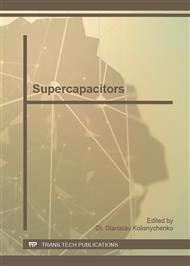p.41
p.47
p.53
p.63
p.69
p.75
p.81
p.87
p.94
Functional Characterisations of Hybrid Nanocomposite Films Based on Polyaniline and Carbon Nanotubes
Abstract:
The combination of nanoparticles and conducting polymers, known as hybrid conducting nanocomposites, is a new emerging field. The combination of conductive polymers, such as polyaniline (PANI), with conductive carbon nanotubes (CNTs) has already shown some synergistic properties. As a consequence, they have a variety of applications, such as sensors, actuators, touch screens, etc.. Usually PANI and CNTs are combined by using electrochemical synthesis starting with the monomer aniline. In this work PANI-CNTs nanocomposite films were obtained by using different combinations of two methods, Electrochemical Deposition (ELD) and Electrophoretic Deposition (EPD). The samples prepared by using these combined methods were compared with the material prepared by the usual electrochemical synthesis. Therefore, all the films so prepared were characterised and their electrochemical properties were investigated, particularly for evaluating their use as supercapacitor components.
Info:
Periodical:
Pages:
81-86
Citation:
Online since:
September 2012
Price:
Сopyright:
© 2013 Trans Tech Publications Ltd. All Rights Reserved
Share:
Citation:



